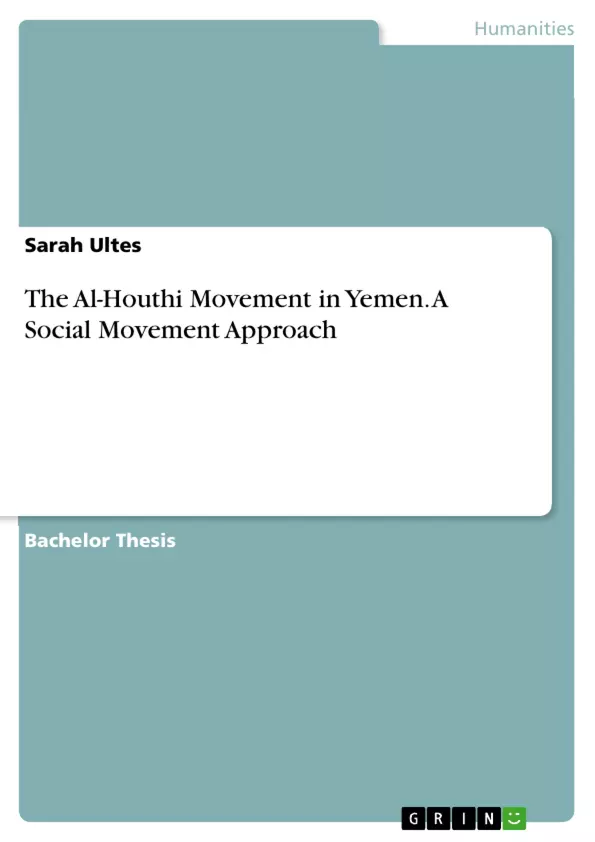
The Al-Houthi Movement in Yemen. A Social Movement Approach
Bachelorarbeit, 2017
46 Seiten, Note: 1.3
Leseprobe
Table of Contents
- 1. Introduction
- 2. Social Movement Theoretical Framework
- 3. The Al-Houthi Movement: Origin and Development
- 3.1. Zaydi History, Culture and Identity 893–1962
- 3.2. Early Zaydi Social Movements 1980s-1990s
- 3.3. Zaydi Radicalization 1986–2004
- 4. The Course of the Houthi Conflict in Yemen
- 4.1. Six Sa'ada Wars 2004-2010
- 4.2. From Arab Spring to Civil War 2011-present
- 5. The Al-Houthi Movement in the light of SMT
- 5.1. Resource and Mobilizing Structures
- 5.1.1. Educational Networks
- 5.1.2. Social and Organizational Networks
- 5.1.3. Financial and Political Resources
- 5.1.4. Rituals and Culture
- 5.1.5. Propaganda and Publicity
- 5.1.6. Military Hardware
- 5.2. Framing Processes
- 5.2.1. Main Governmental Narratives
- 5.2.2. Main Zaydi Revivalist and Houthi Narratives
- 5.3. Opportunities and Constraints
- 5.1. Resource and Mobilizing Structures
Objectives and Key Themes
This paper aims to analyze the Al-Houthi movement in Yemen, moving beyond simplistic explanations of the conflict as a sectarian proxy war. It seeks to understand the movement's evolution from a peaceful social movement to a powerful political force, utilizing a social movement theory (SMT) framework. The study investigates the factors that enabled the movement's emergence and radicalization.
- The Al-Houthi movement's origins and development.
- The role of resources and mobilization strategies in the movement's growth.
- The impact of framing processes and opportunity structures on the movement's trajectory.
- The application of Social Movement Theory (SMT) to understand the Houthi conflict.
- The Houthi movement's transformation from a peaceful to a violent movement.
Chapter Summaries
1. Introduction: This chapter sets the stage by describing the devastating consequences of the Yemeni conflict – over 10,000 deaths, millions displaced, economic collapse, and the rise of extremist groups. It highlights the conflict's relative invisibility in Western media and challenges the simplistic narrative of a sectarian proxy war. The chapter introduces the Al-Houthi movement as a central actor and frames the research questions: What conditions enabled the emergence and radicalization of the Al-Houthi movement? How can SMT explain the movement's growth and shift towards radicalization?
2. Social Movement Theoretical Framework: This chapter establishes the theoretical foundation for the analysis. It introduces Social Movement Theory (SMT), contrasting it with rational choice and structural theories. The chapter discusses key characteristics of social movements, addressing the common challenge of defining them and acknowledging the complexities differentiating social movements from social movement organizations (SMOs). The chapter further refutes the exceptionalism of Islamic activism, arguing that it can be analyzed using the same factors as other social movements: resource availability, framing resources, and shifts in opportunity structures. It introduces resource mobilization theory (RMT) and its focus on the strategic use of both tangible and intangible resources by movements. Finally, it explores framing resources and their significance in shaping collective identity and action.
3. The Al-Houthi Movement: Origin and Development: This chapter delves into the historical roots of the Al-Houthi movement, tracing its origins and key developmental phases. It covers Zaydi history, culture, and identity, the early Zaydi social movements, and the process of Zaydi radicalization leading to the emergence of the Houthi movement as we know it. The chapter is expected to provide a comprehensive historical narrative showcasing how religious, cultural, political, and social factors converged to shape the movement's identity and early trajectory.
4. The Course of the Houthi Conflict in Yemen: This chapter offers a chronological overview of the Houthi conflict, encompassing the six Sa'ada Wars (2004-2010) and the period following the Arab Spring, up to 2017. It analyzes the movement's evolving tactics and strategies, detailing its interactions with the Yemeni government, regional powers, and other actors within the conflict. This summary would likely explore the key events, shifts in power dynamics, and the escalating violence that defined these crucial periods in the Yemeni conflict.
5. The Al-Houthi Movement in the light of SMT: This chapter provides a detailed analysis of the Al-Houthi movement through the lens of SMT, applying the theoretical framework introduced in Chapter 2 to the empirical findings. It examines the movement's mobilization strategies and resource utilization, analyzing the effectiveness of various resources (educational networks, social networks, financial resources, rituals, propaganda, military hardware, etc.) in attracting and retaining followers. Furthermore, this chapter likely examines the framing processes employed by both the Houthi movement and the Yemeni government. The study might also incorporate an analysis of opportunities and constraints that shaped the Houthi movement’s decisions and activities throughout its history.
Keywords
Al-Houthi movement, Yemen, Social Movement Theory (SMT), Resource Mobilization Theory (RMT), Zaydi Shia, conflict, civil war, radicalization, framing, opportunity structures, mobilization, resources, political violence, sectarian conflict, Arab Spring.
Frequently Asked Questions: A Comprehensive Analysis of the Al-Houthi Movement in Yemen
What is the main focus of this document?
This document provides a comprehensive overview and analysis of the Al-Houthi movement in Yemen. It goes beyond simplistic explanations of the conflict as a sectarian proxy war, aiming to understand the movement's evolution and the factors contributing to its emergence and radicalization. The analysis utilizes a Social Movement Theory (SMT) framework.
What are the key themes explored in the analysis of the Al-Houthi movement?
The key themes include the movement's origins and development; the role of resources and mobilization strategies in its growth; the impact of framing processes and opportunity structures on its trajectory; the application of Social Movement Theory (SMT) to understand the Houthi conflict; and the movement's transformation from peaceful to violent actions.
What is the structure of the document?
The document is structured into five chapters. Chapter 1 provides an introduction to the Yemeni conflict and the Al-Houthi movement. Chapter 2 lays out the theoretical framework using Social Movement Theory (SMT). Chapter 3 delves into the historical roots of the Al-Houthi movement. Chapter 4 offers a chronological overview of the Houthi conflict. Finally, Chapter 5 analyzes the Al-Houthi movement through the lens of SMT, examining its mobilization strategies, resource utilization, framing processes, and the opportunities and constraints it faced.
What theoretical framework is used in this analysis?
The analysis primarily utilizes Social Movement Theory (SMT), specifically incorporating aspects of Resource Mobilization Theory (RMT). This framework allows for a nuanced understanding of the movement's growth, considering factors such as resource availability, framing processes, and shifts in opportunity structures.
What historical context is provided for the Al-Houthi movement?
The document traces the historical roots of the Al-Houthi movement, exploring Zaydi history, culture, and identity; early Zaydi social movements; and the process of Zaydi radicalization leading to the emergence of the Houthi movement. It also provides a chronological overview of the Houthi conflict, including the six Sa'ada Wars and the period following the Arab Spring.
How does the document analyze the Al-Houthi movement's mobilization strategies?
The analysis examines the movement's mobilization strategies and resource utilization, including educational networks, social networks, financial resources, rituals, propaganda, and military hardware. It assesses the effectiveness of these resources in attracting and retaining followers.
What role do framing processes play in the analysis?
The analysis examines the framing processes employed by both the Houthi movement and the Yemeni government, understanding how narratives shape collective identity and action. This includes analyzing the main governmental narratives and the main Zaydi revivalist and Houthi narratives.
What are the key resources utilized by the Al-Houthi movement?
The document analyzes various resources employed by the Al-Houthi movement, including educational networks, social and organizational networks, financial and political resources, rituals and culture, propaganda and publicity, and military hardware.
What are the key keywords associated with this analysis?
Key keywords include: Al-Houthi movement, Yemen, Social Movement Theory (SMT), Resource Mobilization Theory (RMT), Zaydi Shia, conflict, civil war, radicalization, framing, opportunity structures, mobilization, resources, political violence, sectarian conflict, Arab Spring.
What is the overall conclusion of this analysis?
The overall conclusion aims to provide a deeper understanding of the Al-Houthi movement's evolution, going beyond simplistic narratives. It leverages SMT to explain the movement's growth and shift towards radicalization, highlighting the interplay of historical context, resource mobilization, framing, and opportunities.
Details
- Titel
- The Al-Houthi Movement in Yemen. A Social Movement Approach
- Hochschule
- Eberhard-Karls-Universität Tübingen (Institute of Political Science)
- Note
- 1.3
- Autor
- Sarah Ultes (Autor:in)
- Erscheinungsjahr
- 2017
- Seiten
- 46
- Katalognummer
- V432219
- ISBN (eBook)
- 9783668744325
- ISBN (Buch)
- 9783668744332
- Dateigröße
- 2792 KB
- Sprache
- Englisch
- Schlagworte
- Houthi Movement - Yemen - Social Movements - Conflict
- Produktsicherheit
- GRIN Publishing GmbH
- Preis (Ebook)
- US$ 20,99
- Preis (Book)
- US$ 30,99
- Arbeit zitieren
- Sarah Ultes (Autor:in), 2017, The Al-Houthi Movement in Yemen. A Social Movement Approach, München, Page::Imprint:: GRINVerlagOHG, https://www.diplomarbeiten24.de/document/432219
- Autor werden
- Ihre Optionen
- Vertriebskanäle
- Premium Services
- Autorenprofil
- Textarten und Formate
- Services für Verlage, Hochschulen, Unternehmen

- © GRIN Publishing GmbH.
- Alle Inhalte urheberrechtlich geschützt. Kopieren und verbreiten untersagt.
- info@grin.com
- AGB
- Open Publishing
Der GRIN Verlag hat sich seit 1998 auf die Veröffentlichung akademischer eBooks und Bücher spezialisiert. Der GRIN Verlag steht damit als erstes Unternehmen für User Generated Quality Content. Die Verlagsseiten GRIN.com, Hausarbeiten.de und Diplomarbeiten24 bieten für Hochschullehrer, Absolventen und Studenten die ideale Plattform, wissenschaftliche Texte wie Hausarbeiten, Referate, Bachelorarbeiten, Masterarbeiten, Diplomarbeiten, Dissertationen und wissenschaftliche Aufsätze einem breiten Publikum zu präsentieren.
Kostenfreie Veröffentlichung: Hausarbeit, Bachelorarbeit, Diplomarbeit, Dissertation, Masterarbeit, Interpretation oder Referat jetzt veröffentlichen!
- GRIN Verlag GmbH
-
- Nymphenburger Str. 86
- 80636
- Munich, Deutschland
- +49 89-550559-0
- +49 89-550559-10
- info@grin.com
-









